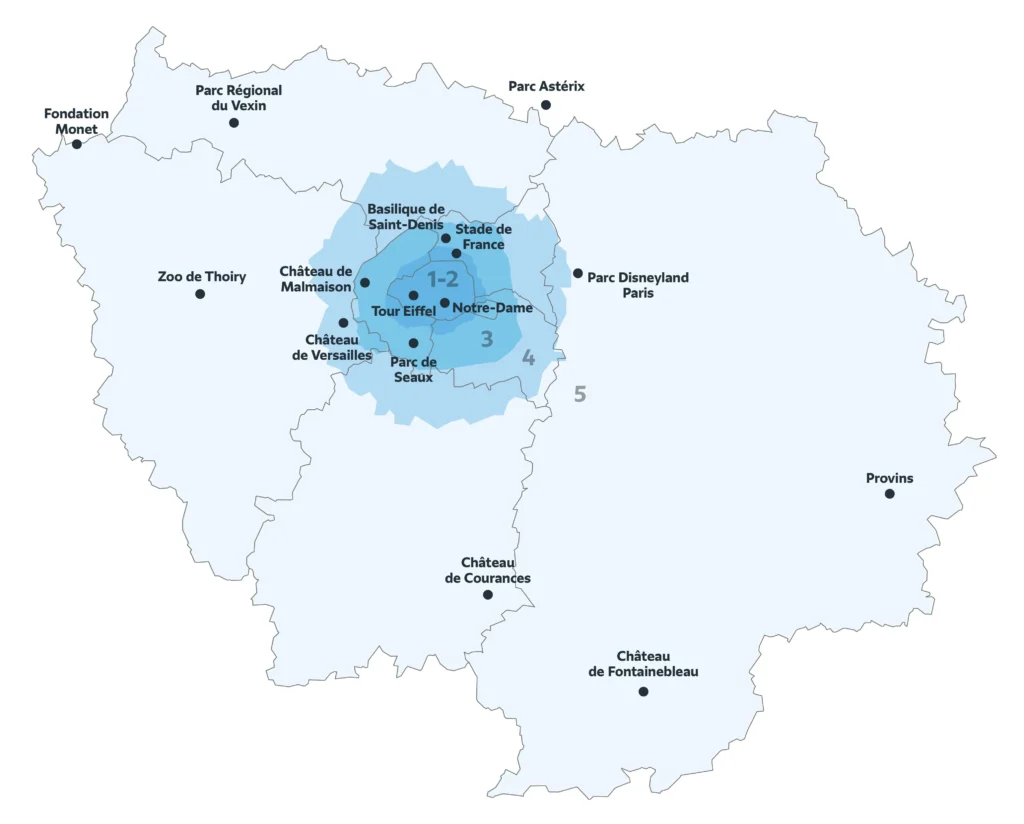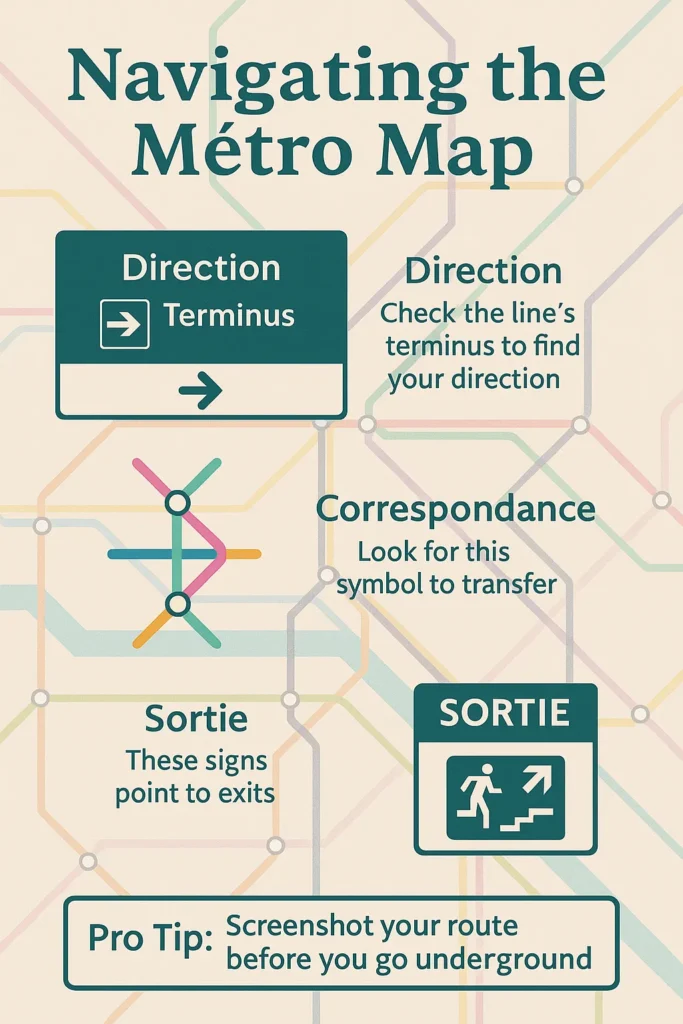Paris unfolds like a story — one you read not from cover to cover, but stop by stop.
The hum of a train beneath your feet. The curve of old tiled tunnels. A busker’s violin echoing down the platform. For a solo traveler, the Paris Métro isn’t just a way to get from A to B — it’s your thread through the city’s rhythm. It connects morning cafés in Montmartre with quiet afternoons in the Latin Quarter. It opens doors to hidden gardens, world-famous galleries, and moonlit walks along the Seine.
Yes, it can feel overwhelming at first — unfamiliar signs, fast-moving crowds, machines with too many buttons. But that moment of hesitation? It’s short-lived. With a little guidance, what first seemed like a maze becomes a map. And in that shift, something beautiful happens: you stop feeling like a tourist and start moving like a local.
We created this guide for you — the curious, discerning explorer. We’ll walk you through every step of using the Paris Métro, from choosing the right ticket to navigating transfers with grace. Whether it’s your first time underground or you’re simply seeking a smoother solo journey, consider this your invitation to travel with confidence.
Let’s begin.
Métro vs. RER: Demystifying the Paris Train Map
If you think that the Paris train system looks like a plate of tangled spaghetti, you’re not alone. But beneath the swirl of colored lines lies a beautifully efficient rhythm — once you understand the basics, it all starts to click.
Let’s begin with the two systems you’ll see on every map:
The Métro: Paris in Close-Up
The Métro is Paris’s urban heartbeat. With 16 numbered lines (1 to 14, plus 3bis and 7bis), it connects nearly every neighborhood inside the city. Stations are close together, trains arrive every few minutes, and the stops have wonderfully evocative names like Odéon, République, or Porte de Clignancourt.
Think of it like a zoomed-in lens — the Métro lets you explore the city block by block.
Each line has its own number and color. For example, Line 1 is yellow and crosses east to west. Line 4 is purple and runs north to south. Most signs and digital displays will show both the line number and the terminus station — this is how you know which direction the train is heading.
The RER: The Wider Circle
The RER (Réseau Express Régional) looks similar on the map, but it’s a different beast. These are commuter trains that connect the city to the suburbs — and to major places like Versailles, Charles de Gaulle Airport, and Disneyland Paris.
There are five lines, labeled A to E, and they run faster, stop less frequently, and often operate on a different ticketing system when crossing out of central Paris.
A simple way to think about it:
🟢 The Métro is your day-to-day sketchbook — quick, close, full of little discoveries.
🔵 The RER is your passport — broader, faster, ready to take you beyond the city’s borders.
As a solo traveler, you’ll likely use the Métro far more often — but knowing when (and how) to hop on the RER can make your journey smoother, especially when heading to the airport or a day trip destination.
🧭 Quick Visual Tip: Telling the Métro and RER Apart
Métro signs are usually marked with a bold “M” inside a colored circle or classic Art Nouveau ironwork arches. You’ll often see line numbers like M4 or M12 on digital signs and platforms.
RER signs use the letters A–E, displayed in round white circles with a blue outline. For example: RER A, RER B.
📍 In stations, signs will guide you with both icons and text. Look for:
- “Correspondance M” → Transfer to another Métro line
- “Correspondance RER” → Transfer to an RER line
- “Sortie” → Exit
- “Direction” → Tells you the final station the train is heading toward (your compass for choosing the right side of the platform)
The Key to the City: A Solo Traveler’s Guide to Paris Métro Tickets (2025)
Riding the Paris Métro isn’t just about moving from point A to B—it’s about moving through a rhythm of daily life, one that locals know by heart. For the solo traveler, having the right ticket isn’t just a matter of cost; it’s the first choice in setting your pace and shaping your Paris experience.
Let’s explore your ticketing options with clarity, strategy, and a solo traveler’s mindset.
| Ticket Type | Best For | Price (2025) | Pros | Cons |
|---|---|---|---|---|
| Single Ticket (t+) | 1–2 short rides | €2.15 | No commitment, easy to get | Adds up fast if used multiple times daily |
| Navigo Easy Pass | 2–4 day stays | €2 (card) + loadable tickets | Great for digital 10-packs, no paper waste | Card must be purchased & reloaded |
| Paris Visite Pass | 1–5 day tourist trips | €13.55+/day | Simple for tourists, includes some discounts | Expensive for light users |
| Navigo Semaine (Weekly) | 5–7 day trips (incl. Monday) | €30.75 | Best value if in Paris Mon–Sun, incl. CDG/Orly | Must buy by Thursday, needs photo |
✱ Paper “Carnets” of 10 tickets are no longer sold. Use Navigo Easy for 10-packs.
The Navigo Découverte Explained: When This Pass Is a Smart Choice
The Navigo Découverte is a local secret that many tourists overlook. It’s not flashy or tourist-branded—it’s the real commuter’s choice.
How it works:
- Buy the Navigo Découverte card (€5) at any major station.
- Add a weekly pass (Navigo Semaine) for €30.75 covering Zones 1–5.
- You’ll need a passport-sized photo (can be printed at machines in stations).
Valid from Monday to Sunday only (not 7 days from purchase!). So:
- Perfect for: Travelers spending 5–7 days in Paris and arriving before Thursday.
- Not ideal for: Weekends-only visits or arrivals late in the week.
🧭 JourneyGazer Tip
💡 Pro Tip: This pass includes RER to CDG, Orly, and even Versailles—a huge value if those are on your list.
Understanding Paris Zones
image source: Île-de-France
Paris transport is divided into concentric fare zones (1–5), but here’s the good news: almost everything a visitor needs is in Zone 1.
| Zone | What It Covers |
|---|---|
| 1 | Central Paris, major landmarks |
| 2–3 | Just outside city core, residential areas |
| 4–5 | Suburbs, airports, Versailles |
Most tickets and passes are sold for Zones 1–3 by default, but here’s when you’ll need broader access:
- Zone 4: Versailles
- Zone 5: Charles de Gaulle (CDG), Orly Airport, Disneyland Paris
🧭 JourneyGazer Tip
🎯 Solo Tip: If you’re only traveling within central Paris, don’t overpay. But if your journey stretches beyond, plan smart and check the zones in advance.
How to Pay in 2025: From Ticket Machines to Tapping Your Phone
The Paris Métro has embraced the future without abandoning the familiar. Whether you’re holding a paper ticket, a plastic card, or just your smartphone, paying for your ride has never been easier—or more adaptable to your preferences.
The Classic Way: Using a Ticket Machine Step-by-Step
If you like doing things the traditional way—or just don’t want to rely on your phone—ticket machines are still a perfectly solid choice. Here’s how to glide through the process:
- Find a machine: Located in every station, usually near the main entrance.
- Select your language: English, Spanish, German, and more are available.
- Choose your ticket type: Single, 10-pack, Navigo Easy top-up, etc.
- Select quantity: How many tickets do you need?
- Pay: Use a card or cash (note: not all machines accept coins or bills).
- Collect your ticket(s): And don’t forget your receipt if needed.
🧭 JourneyGazer Tip
If you’re using a Navigo Easy card, choose the reload/top-up option. The interface guides you step by step.
The Modern Way: Using Your Phone (Apple & Google Pay)
For the solo traveler who values speed and minimal fuss, contactless payment is a game-changer. Here’s how it works:
- Just tap: If your phone is equipped with Apple Pay, Google Pay, or any compatible NFC payment method, simply tap it directly on the Métro turnstile reader. That’s it—you’re in.
- One tap = one ride: Each tap deducts a standard fare. Transfers (between Métro and RER, for example) are tracked automatically within the 90-minute transfer window.
- No extra fees: You’re charged the same base rate as a regular ticket. No tourist mark-ups.
- Want to plan ahead? Download the Île-de-France Mobilités app to check routes, recharge cards, and use digital tickets.
🧭 JourneyGazer Tip
This is especially useful if you’re hopping between destinations and don’t want to queue at machines or carry multiple cards.
Whether you’re tapping plastic or digital glass, what matters most is this: you’ve got options—and each one can carry you closer to that perfect Paris moment.
Riding Like a Local: A Solo Traveler’s Guide to Etiquette & Safety
Using the Paris Métro is more than a means of transport—it’s an art of flow, rhythm, and quiet courtesy. When you ride like a local, you experience Paris as Parisians do: with purpose, calm, and grace.
Unwritten Rules: Métro Etiquette to Blend In
Small acts go a long way on the Métro. Here’s how to move respectfully and comfortably:
- Stand on the right side of escalators; let others pass on the left.
- Offer your seat (especially the fold-down “strapontins”) to elderly passengers, people with disabilities, or parents with children.
- Keep noise to a minimum—phone calls and loud conversations are frowned upon.
- Say “pardon” gently if you need to pass.
- Wait for others to exit before boarding.
🧭 JourneyGazer Tip
Watching how Parisians move—calm, aware, unfussy—is the best way to learn.
Navigating with Confidence: A Step-by-Step Journey
Let’s say you’re heading from Montparnasse to the Marais. Here’s what your ride might look like:
- Find your entrance — Some stations have multiple; look for your line number and color.
- Pass through the turnstile — Use your ticket or phone.
- Find the correct platform — Use the destination station (end of the line) to orient.
- Board and ride — Announcements and signs inside the train show the next stop.
- Transfer (correspondance) — Follow signs with your next line’s color and number.
- Exit (sortie) — Each exit is numbered and labeled with the streets above.
🎯 Solo Tip:
Travel during off-peak hours (10 a.m.–4 p.m. or after 7 p.m.) for more space and calm.
Staying Safe: Practical Awareness for Solo Travel
Paris is generally safe, but like any large city, awareness matters—especially when you’re traveling solo.
Keep these things in mind:
- Secure your valuables — Use a crossbody bag, zipped and close to you.
- Avoid visibly using your phone near train doors where snatching can occur.
- Stay alert in busy stations like Châtelet–Les Halles or Gare du Nord, especially late at night.
- Know your exit — Don’t linger looking lost; plan your route in advance.
💡 Empowerment Over Fear: You belong here. A little confidence goes a long way.
⚠️ Mistakes to Avoid on the Paris Métro
| Mistake | Why It Matters |
|---|---|
| Entering without a validated ticket | Risk of fines from random inspections |
| Tossing your ticket too early | You’ll need it to exit at some stations |
| Riding during rush hour with luggage | It’s stressful—for you and everyone else |
| Forgetting the last train time (esp. Sundays) | Trains don’t run 24/7; you might end up stranded |
🧭 JourneyGazer Tip
Always check your route on a transit app or Google Maps before heading out, especially at night.
Frequently Asked Questions (FAQ)
Here are quick answers to some of the most common questions solo travelers have about the Paris Métro.
What are the Paris Métro operating hours?
Generally, the Métro runs from approximately 5:30 AM to 1:15 AM from Sunday to Thursday. On Fridays, Saturdays, and the nights before a public holiday, service is extended until about 2:15 AM. However, these are general times. The time of the last train for your specific line and direction can vary, so it’s always wise to check a transit app like Citymapper or the official Bonjour RATP app if you plan on being out late.
Is the Paris Métro accessible for travelers with mobility issues?
To be direct, the historic Paris Métro system is notoriously challenging for accessibility. Due to its age and deep tunnels, the vast majority of stations do not have elevators or ramps, making them unsuitable for wheelchair users or those who cannot manage many stairs. However, there are excellent alternatives: The RER lines generally have better accessibility than the Métro, but it varies by station. Always check your specific journey on an app with an accessibility filter. Line 14 is the most modern, fully automated, and fully accessible line. The Paris bus and tram networks are almost entirely accessible and offer a fantastic way to see the city.
Can I use my Métro ticket on the bus?
Yes, the standard single ticket (called a “t+”) is versatile, but there’s a key rule about transfers. You can use one t+ ticket for a single continuous journey on the Métro and RER network (within Zone 1). You can also use it for a bus or tram journey, with free transfers to other buses or trams within a 90-minute window from your first validation. The crucial thing to remember is that you cannot transfer from the Métro/RER to a bus/tram on the same single ticket. Once you exit the underground system, you will need a new ticket to board a bus or tram.
What do I do if I lose my ticket inside the system?
This is a situation worth avoiding, as you need your ticket to exit certain RER stations and for random inspections (contrôles), which are common. If you are caught without a valid ticket, you will be fined.Always keep your ticket in a secure and easily accessible spot until you have fully exited the station at your destination. If you do lose it, the best course of action is to find a station agent at a ticket window (guichet), politely explain the situation (“J’ai perdu mon ticket”), and they may be able to help. However, be prepared that you may have to buy a new single ticket to be able to exit the turnstiles.
Is there Wi-Fi or cell service in the Métro?
Yes. As of 2025, you can expect to stay connected throughout your journey. The entire RATP network, including all Métro lines and stations, is equipped with 4G/5G mobile coverage. This means your maps, messaging apps, and browsers should work seamlessly underground, which is incredibly helpful for navigating on the fly. Additionally, free Wi-Fi is available in most stations.
Your First Ride: A Moment Just for You
If your first ride begins on Line 6, near the Seine…
The train hums into the station with a familiar rhythm, and you step aboard. A window seat calls to you. You sit, not rushed, not flustered — just observant.
As the train rises onto the viaduct between Bir-Hakeim and Passy, the city opens like a whispered secret. The Eiffel Tower appears beside you, framed perfectly through the glass. It’s not a grand entrance. No one claps. No music swells. And yet — it’s perfect.
The moment is quiet. Yours alone.
You’re not just in Paris now. You’re moving with it.
Conclusion: The Métro Is Yours Now
What once felt like a maze is now a map — and you hold the key.
You’ve learned the difference between the Métro and the RER, how to choose the right pass for your trip, where each zone leads, and how to glide through turnstiles with a tap of your phone or the quiet crinkle of a ticket. You know the unspoken rules, the solo travel tips, and the rhythm of the ride.
The Paris Métro isn’t just a way to get around. It’s your passage into the heart of the city — a chance to move like a local, see more than the guidebooks show, and find meaning between the stops.
And now that you’ve mastered getting around, why not see where the rails can take you?
👉 Discover the best things to do, eat, and experience in our Ultimate Guide to Solo Travel in Paris.
Your journey is just beginning.






